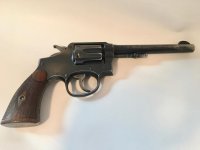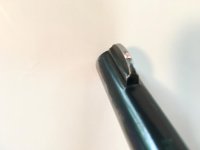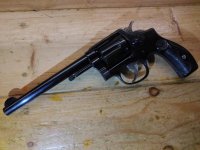Some pretty bad condition grips can be salvaged by wood splicing, careful rreshaping the repairs, matching colors and grain and theen recheckering.
Lots of different techniques and not all are used in every job.
Re-checkering and checkering new work is a trade in itself.
It can be labor intensive and boring but otherwise the finishing touch on the project.
Checkering tools of late have become extremely expensive. The old line mfg'rs of them have seemingly dropped off in interest in making them in any numbers. Plus the quality is lacking in many. There are a couple newer names in the biz and they are good. But prices are not what they used to be that's for sure.
Re-checkering can have it's own issues.
One is that old work doesn't always line up exactly with the standard LPI tools. What was listed as 20LPI may actually have been cut as 20.5 or some other very close but not exact LPI.
If you re-cut one of those non-exact patterns with an eact LPI tool, you will seemingly be right on the money for the first couple of rows, but then the spacing starts to go off. The more rows you cut, the worse it gets and soon you are splitting old diamonds.
A new space tool that is a mere .003 wider than the old orig pattern lines will be cutting the 10th row .030" over from where the old pattern has it placed.
You will have certainly over-run the old diamonds by then if not aware of what's happening and messed up the pattern.,,and thats only a 1/2" width of 20LPI checkering on a flat surface.
Many older tools were hand made. Many were resharpened by hand. Some of the early commercial made tool heads were resharpened by hand as well. This all changed the LPI spacing of the tool ever so slightly.
Single point tools are great for re-cutting. But when the orig pattern is very weak or nonexistant, going by eye-ball method spacing really shows up.
The other main issue with recutting older work is that is very tough on the tools. Old work holds dried oil, dirt, grime, sand,,all things that quickly dull a checkering tools.
A CArbide checkering tool works great in recutting and is good for a once over on each line to deepen and clean out the crud. Then go back and deepen, get the spacing nice and even with the steel cutters.
If you find the standard steel cutters pricey, wait till you see what a single point Carbide tool costs.
Then there are the electric Checkering machines. Rotary cutters generally and Carbide. MMC was one of the first. There are few different ones around now.
Around $1400 to 2400, so usually for someone that's doing a lot of work. A great time saver, so a money maker as well.
I bought one in the 70's when I was doing a lot of checkering and still use it for layout the pattern. Then finish up with the hand tools.
You can get yourself into trouble with one real quick!
Here's some pics of set of pre-war 38-44 grips that were terribly cobbles and sliced up.
No particular order..
The front straps were carved up, the lower edges had wood missing, severe dents around the medallions which I did not want to remove to repair.
Wood surfaces were cleared and smoothed so new wood could be glued back into place.
New 'diamonds' were added to replace the damaged area ones. Oversize as added and then carefully cut to size as the re-checkering was done.






One oddity about this set of grips is that the back sides of each panel had to have wood added to make them set flat against the frame both at the ear and against the grip frame.
But one need wood one the 'ear'..the other on the grip frame area.
These pics show the back side of the grips in their orig wood.\
Then with 'New Wood' added to each, One one the Ear,,One on the Grip Frame area.. The lighter clean colored wood is the new added wood.
It is 1/32" thickness European Walnut veneer.
Glued to each panel and trimmed to fit, this brought each panel to dimension for a flat fit to the frame sides.


Finished sanded and fitted. Checkered and ready for wood stain and finish.
I have pics of the final product but the IMGBB site isn't co-operating tonite.

























